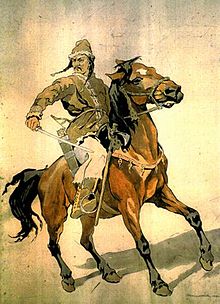The history of Slovakia dates back to the findings of ancient human artifacts. This article shows the history of the country from prehistory to the present day.
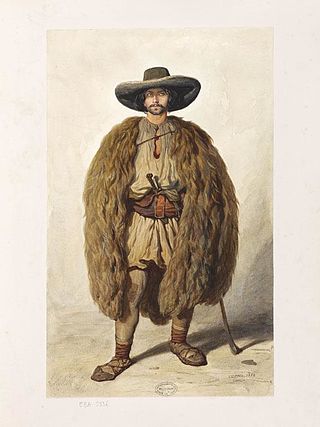
Vlach, also Wallachian, is a term and exonym used from the Middle Ages until the Modern Era to designate speakers of Eastern Romance languages living in Southeast Europe — south of the Danube and north of the Danube.

An ice axe is a multi-purpose hiking and climbing tool used by mountaineers in both the ascent and descent of routes that involve snow, ice, or frozen conditions. Its use depends on the terrain: in its simplest role it is used like a walking stick, with the mountaineer holding the head in the center of their uphill hand.

Juraj Jánošík was a Slovak highwayman. Jánošík has been the main character of many Slovak novels, poems, and films. According to the legend, he robbed nobles and gave the loot to the poor, a deed often attributed to the famous Robin Hood. The legend is known in neighboring Poland and the Czech Republic as well as Slovakia. The actual robber had little to do with the modern legend, whose content partly reflects the ubiquitous folk myths of a hero taking from the rich and giving to the poor. However, the legend was also shaped in important ways by the activists and writers in the 19th century when Jánošík became the key highwayman character in stories that spread in the north counties of the Kingdom of Hungary and among the local Gorals inhabitants of the Podhale region north of the Tatras. The image of Jánošík as a symbol of resistance to oppression was reinforced when poems about him became part of the Slovak and Czech middle and high school literature curriculum, and then again with the numerous films that propagated his modern legend in the 20th century. During the anti-Nazi Slovak National Uprising, one of the partisan groups bore his name.
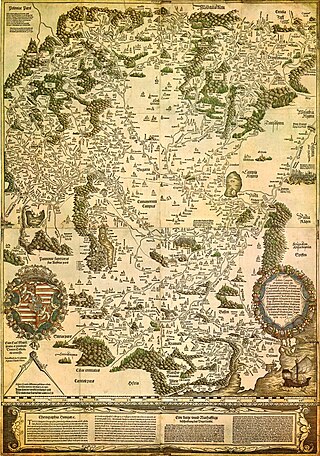
The history of Hungarybefore the Hungarian conquest spans the time period before the Hungarian conquest in the 9th century of the territories that would become the Principality of Hungary and the Kingdom of Hungary.

Katarínka are the ruins of a Franciscan monastery and church dating back to the early 17th century, located deep in the forests of the Little Carpathians in western Slovakia, 20 km north of Trnava over Dubovský creek, close to the villages of Dechtice, Naháč and Dobrá Voda. The church was dedicated to Saint Catherine of Alexandria, and that is where the nickname of the place Katarínka comes from.
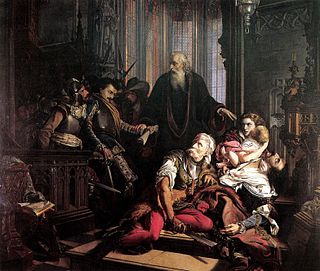
Kuruc, also spelled kurutz, refers to a group of armed anti-Habsburg insurgents in the Kingdom of Hungary between 1671 and 1711.

Glad was the ruler of Banat at the time of the Hungarian conquest of the Carpathian Basin around 900 AD, according to the Gesta Hungarorum. The Gesta, which was written by an author known in modern scholarship as Anonymus in the second half of the 12th century or in the early 13th century, is the earliest extant Hungarian chronicle. The Gesta did not refer to the enemies of the conquering Hungarians, who had been mentioned in earlier annals and chronicles, but wrote of a dozen persons, including Glad, who are unknown from other primary sources of the Hungarian Conquest. Therefore, modern historians debate whether Glad was an actual enemy of the conquerors or only a "fictitious person" made up by Anonymus. In Romanian historiography, based on the mention by Anonymus some 300 years later, Glad is described as one of the three Romanian dukes who ruled a historical region of present-day Romania in the early 10th century.

Upper Hungary is the usual English translation of Felvidék, the Hungarian term for the area that was historically the northern part of the Kingdom of Hungary, now mostly present-day Slovakia. The region has also been called Felső-Magyarország.
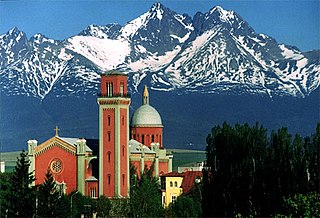
Kežmarok is a town in the Spiš region of eastern Slovakia, on the Poprad River. Prior to World War I, it was in Szepes county in the Kingdom of Hungary.

Hősök tere is one of the major squares in Budapest, Hungary, noted for its iconic Millennium Monument with statues featuring the Seven chieftains of the Magyars and other important Hungarian national leaders, as well as the Memorial Stone of Heroes, often erroneously referred as the Tomb of the Unknown Soldier. The square lies at the outbound end of Andrássy Avenue next to City Park (Városliget). It hosts the Museum of Fine Arts and the Palace of Art (Műcsarnok). The square has played an important part in contemporary Hungarian history and has been a host to many political events, such as the reburial of Imre Nagy in 1989. Most sculptures were made by sculptor György Zala from Lendava, with one made by György Vastagh.

Moravian Wallachia is a mountainous ethnoregion located in the easternmost part of Moravia in the Czech Republic, near the Slovak border, roughly centered on the cities Vsetín, Valašské Meziříčí and Rožnov pod Radhoštěm. The name Wallachia used to be applied to all the highlands of Moravia and the neighboring Silesia, although in the 19th century a smaller area came to be defined as ethno-cultural Moravian Wallachia. The traditional dialect represents a mixture of elements from the Czech and Slovak languages, and has a distinct lexicon of Romanian origin relating to the pastoral economy of the highlands. The name originated from the term "Vlach", the exonym of Romanians.

The Gorals, also known as the Highlanders are an ethnographic subgroup primarily found in their traditional area of southern Poland, northern Slovakia, and in the region of Cieszyn Silesia in the Czech Republic, where they are known as the Silesian Gorals. There is also a significant Goral diaspora in the area of Bukovina in western Ukraine and in northern Romania, as well as in Chicago, the seat of the Polish Highlanders Alliance of North America.

The Principality of Nitra, also known as the Duchy of Nitra, was a West Slavic polity encompassing a group of settlements that developed in the 9th century around Nitra, in present-day Slovakia. Its history remains uncertain because of a lack of contemporary sources. The territory's status is subject to scholarly debate: some modern historians describe it as an independent polity that was annexed either around 833 or 870 by the Principality of Moravia, while others say that it was under the influence of the neighbouring West Slavs from Moravia from its inception.
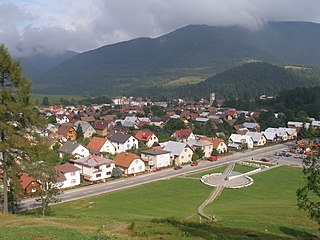
Terchová is a large village and municipality in the Malá Fatra mountains in the Žilina District in the Žilina Region of northern Slovakia.
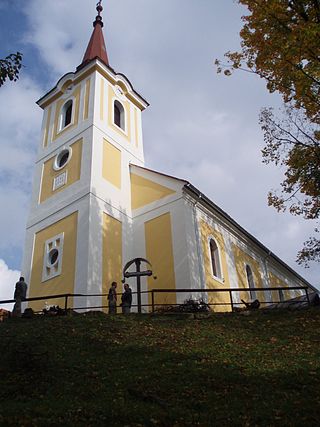
Pohorelá is a village and municipality in the Brezno District, of the Banská Bystrica Region of central Slovakia. It is located in the foothills of the Low Tatras range of the Carpathian Mountains, on the right bank of the upper Hron River. The village is located 33 km east of Brezno, 49 km southwest of Poprad, and 37 km north of Tisovec on First Class Road 66. Pohorelá is the third largest village of the Horehronie region. The Roman Catholic Pohorela church, built in 1762, is a dominant feature of the village. The village was known as Garamkohó for a time in the early 20th century.

Jánošík is a Slovak black-and-white silent film from 1921. It relates the popular legend of the highwayman Juraj Jánošík. It shows the filmmakers' experience with early American movies in camera work, in the use of parallel narratives, and in sequences inspired by Westerns. Jánošík placed Slovak filmmaking as the 10th national cinema in the world to produce a full-length feature movie.

The Executive Court of Prešov, also known as Caraffa's slaughter, was an extraordinary cruel political court founded by the Neapolitan count and imperial general Antonio Caraffa in 1687 in Prešov (Eperjes), Kingdom of Hungary to punish followers of Imre Thököly, leader of anti-Habsburg rebellion. Result of the court was execution of more than 24 Hungarians, Germans and Slovaks. While some of those executed had taken part in rebellion, many of them were innocent and had been falsely accused.

The Hungarian conquest of the Carpathian Basin, also known as the Hungarian conquest or the Hungarian land-taking, was a series of historical events ending with the settlement of the Hungarians in Central Europe in the late 9th and early 10th century. Before the arrival of the Hungarians, three early medieval powers, the First Bulgarian Empire, East Francia, and Moravia, had fought each other for control of the Carpathian Basin. They occasionally hired Hungarian horsemen as soldiers. Therefore, the Hungarians who dwelt on the Pontic-Caspian Steppe east of the Carpathian Mountains were familiar with what would become their homeland when their conquest started.
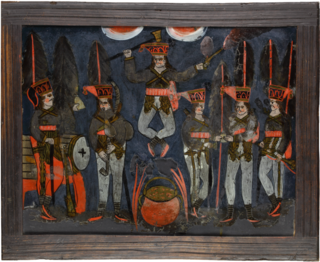
Jakub Surovec, more commonly known in Poland as Jakub Surowiec was a Slovak outlaw, one of the most famous in the country. Along with his group, he engaged in banditry across significant areas of the Central and Inner Western Carpathians. Challenging the feudal system, he gained considerable recognition among the impoverished population. After capturing Surovec, Austrian authorities sentenced him to death. Tales of him made their way into fiction; he is portrayed in a significant number of Polish and Slovak works of art depicting outlaw themes. He is often mistakenly believed to be associated with Juraj Jánošík.

